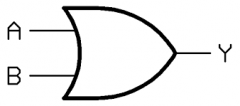![]()
![]()
![]()
Use LEFT and RIGHT arrow keys to navigate between flashcards;
Use UP and DOWN arrow keys to flip the card;
H to show hint;
A reads text to speech;
23 Cards in this Set
- Front
- Back

|
AND gate |
|
|
f = A·B or f = AB |
AND gate statement |
|

|
OR gate |
|
|
f=X+Y |
OR gate statement |
|

|
NOT gate (Inverter) |
|
|
A=Not A or Input=Not Output |
NOT gate (Inverter) statement |
|

|
NAND gate |
|
|
f=Not(XY) |
NAND gate statement |
|

|
NOR gate |
|
|
f=NOT(A+B) |
NOR gate statement |
|
|
A term that is TRUE in one part of an expression will be TRUE in all parts of the expression
(A = A or A = A). |
LAW OF IDENTITY |
|
|
The order in which terms are written does not affect their value
(AB = BA, A+B = B+A). |
COMMUTATIVE LAW |
|
|
A simple equality statement
A(BC) = ABC or A+(B+C) = A+B+C. |
ASSOCIATIVE LAW |
|
|
A term ANDed with itself or ORed with itself is equal to that term
(AA = A, A+A = A). |
IDEMPOTENT LAW |
|

A term that is inverted twice is equal to the term |
DOUBLE NEGATIVE LAW |
|
|
A term ANDed with its complement equals 0, and a term ORed with its complement equals 1.
AA' = 0 A + A' = 1 |
COMPLEMENTARY LAW |
|
|
a term ANDed with 1 equals that term and a term ANDed with 0 equals 0
(A·1 = A, A·0 = 0) |
LAW OF INTERSECTION |
|
|
A term ORed with 1 equals 1 and a term ORed with 0 equals that term
(A+1 = 1, A+0 = A). |
LAW OF UNION |
|

|
DeMORGAN’S THEOREM |
|

|
DeMORGAN’S THEOREM |
|
|
(1) A·(B+C) = AB+AC;
(2) A+(BC) = (A+B) · (A+C). |
DISTRIBUTIVE LAW |
|
|
A·(A+B) = A or
A+(AB) = A. |
LAW OF ABSORPTION |
|
|
A'(A'+B) = AB and A+AB = A+B |
LAW OF COMMON IDENTITIES |

